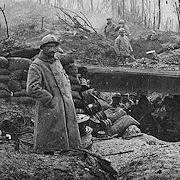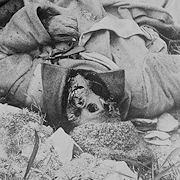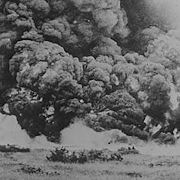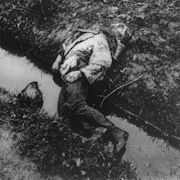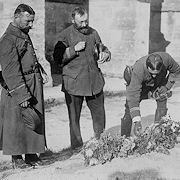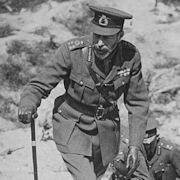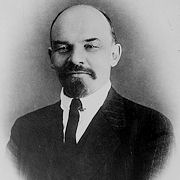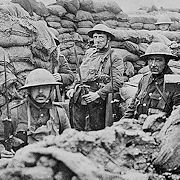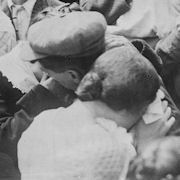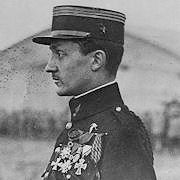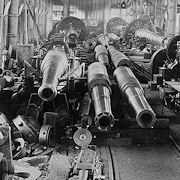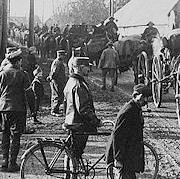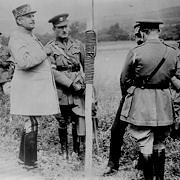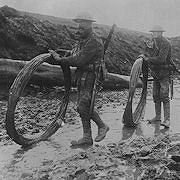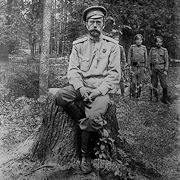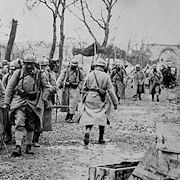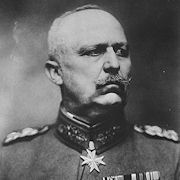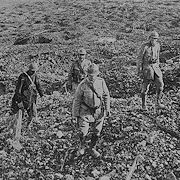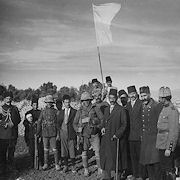
1917 : The Rage of Men
January 19, 1917 - The British intercept a telegram sent by Alfred Zimmermann in the German Foreign Office to the German embassies in Washington, D.C., and Mexico City. Its message outlines plans for an alliance between Germany and Mexico against the United States. According to the scheme, Germany would provide tactical support while Mexico would benefit by expanding into the American Southwest, retrieving territories that had once been part of Mexico. The Zimmermann telegram is passed along by the British to the Americans and is then made public, causing an outcry from interventionists in the U.S., such as former president Teddy Roosevelt, who favor American military involvement in the war. February 1, 1917 - The Germans resume unrestricted submarine warfare around the British Isles with the goal of knocking Britain out of the war by cutting off all imports to starve the British people into submission. February 3, 1917 - The United States severs diplomatic ties with Germany after a U-Boat sinks the American grain ship Housatonic. Seven more American ships are sunk in February and March as the Germans sink 500 ships in just sixty days. February 25, 1917 - In the Middle East, newly reinforced and replenished British troops retake Kut al-Amara in Mesopotamia from outnumbered Turks. The British then continue their advance and capture Baghdad, followed by Ramadi and Tikrit. Russian Revolution March 8, 1917 - A mass protest by Russian civilians in Petrograd (St. Petersburg) erupts into a revolution against Czar Nicholas II and the war. Within days, Russian soldiers mutiny and join the revolution. March 15, 1917 - The 300-year-old Romanov dynasty in Russia ends upon the abdication of Czar Nicholas II. In his place, a new democratically minded Provisional Government is established. Great Britain, France, the United States, and Italy rush to recognize the new government in the hope Russia will stay in the war and maintain its huge presence on the Eastern Front. March 15, 1917 - Germans along the central portion of the Western Front in France begin a strategic withdrawal to the new Siegfried Line (called the Hindenburg Line by the Allies) which shortens the overall Front by 25 miles by eliminating an unneeded bulge. During the three-week long withdrawal, the Germans conduct a scorched earth policy, destroying everything of value. April 1917 - British combat pilots on the Western Front suffer a 50 percent casualty rate during Bloody April as the Germans shoot down 150 fighter planes. The average life expectancy of an Allied fighter pilot is now three weeks, resulting from aerial dogfights and accidents. America Enters April 2, 1917 - President Woodrow Wilson appears before the U.S. Congress and gives a speech saying "the world must be made safe for democracy" then asks the Congress for a declaration of war against Germany. April 6, 1917 - The United States of America declares war on Germany. April 9, 1917 - The British Army has one of its most productive days of the war as 3rd Army, supported by Canadian and Australian troops, makes rapid advances north of the Hindenburg Line at Arras and Vimy on the Western Front. The expansive first-day achievement in snowy weather includes a 3.5 mile territorial gain and the capture of Vimy Ridge by Canadians. However, similar to past offensives, the inability to capitalize on initial successes and maintain momentum gives the Germans an opportunity to regroup and further gains are thwarted. The British suffer 150,000 casualties during the offensive, while the Germans suffer 100,000. Nivelle Offensive April 16, 1917 - The French 5th and 6th Armies attack along a 25-mile front south of the Hindenburg Line. The new offensive comes amid promises of a major breakthrough within 24-hours by the new French Commander-in-Chief, Robert Nivelle, who planned the operation. Nivelle once again utilizes his creeping barrage tactic in which his armies advance in stages closely behind successive waves of artillery fire. However, this time it is poorly coordinated and the troops fall far behind. The Germans also benefit from good intelligence and aerial reconnaissance and are mostly aware of the French plan. Nivelle's offensive collapses within days with over 100,000 casualties. French President Poincaré personally intervenes and Nivelle is relieved of his command. He is replaced as Commander-in-Chief by General Henri Petain, who must deal with a French Army that is now showing signs of mutiny. April 16, 1917 - Political agitator Vladimir Lenin arrives back in Russia, following 12 years of exile in Switzerland. Special train transportation for his return was provided by the Germans in the hope that anti-war Lenin and his radical Bolshevik Party will disrupt Russia's new Provisional Government. Lenin joins other Bolsheviks in Petrograd who have already returned from exile including Joseph Stalin. May 18, 1917 - The Selective Service Act is passed by the U.S. Congress, authorizing a draft. The small U.S. Army, presently consisting of 145,000 men, will be enlarged to 4,000,000 via the draft. May 19, 1917 - The Provisional Government of Russia announces it will stay in the war. A large offensive for the Eastern Front is then planned by Alexander Kerensky, the new Minister of War. However, Russian soldiers and peasants are now flocking to Lenin's Bolshevik Party which opposes the war and the Provisional Government. French Mutiny May 27-June 1, 1917 - The mutinous atmosphere in the French Army erupts into open insubordination as soldiers refuse orders to advance. More than half of the French divisions on the Western Front experience some degree of disruption by disgruntled soldiers, angry over the unending battles of attrition and appalling living conditions in the muddy, rat and lice-infested trenches. The new Commander-in-Chief, Henri Petain, cracks down on the mutiny by ordering mass arrests, followed by several firing squad executions that serve as a warning. Petain then suspends all French offensives and visits the troops to personally promise an improvement of the whole situation. With the French Army in disarray the main burden on the Western Front falls squarely upon the British. June 7, 1917 - A tremendous underground explosion collapses the German-held Messines Ridge south of Ypres in Belgium. Upon detonation, 10,000 Germans stationed on the ridge vanish instantly. The British then storm the ridge forcing the surviving Germans to withdraw to a new defensive position further eastward. The 250-foot-high ridge had given the Germans a commanding defensive position. British, Australian and Canadian tunnelers had worked for a year to dig mines and place 600 tons of explosives. June 13, 1917 - London suffers its highest civilian casualties of the war as German airplanes bomb the city, killing 158 persons and wounding 425. The British react to the new bombing campaign by forming home defense fighter squadrons and later conduct retaliatory bombing raids against Germany by British planes based in France. June 25, 1917 - The first American troops land in France. July 1, 1917 - Russian troops begin the Kerensky Offensive attempting to recapture the city of Lemberg (Lvov) on the Eastern Front. The Germans are lying in wait, fully aware of the battle plans which have been leaked to them. The Russians attack along a 40-mile front but suffer from a jumble of tactical problems including a lack of artillery coordination, poor troop placement, and serious disunity within the ranks reflecting the divisive political situation back home. The whole offensive disintegrates within five days. Sensing they might break the Russian Army, the Germans launch a furious counter-offensive and watch as Russian soldiers run away. July 2, 1917 - Greece declares war on the Central Powers, following the abdication of pro-German King Constantine who is replaced by a pro-Allied administration led by Prime Minister Venizelos. Greek soldiers are now added to the Allied ranks. Third Battle of Ypres July 31, 1917 - The British attempt once more to break through the German lines, this time by attacking positions east of Ypres, Belgium. However, by now the Germans have vastly improved their trench defenses including well-positioned artillery. Although the British 5th Army succeeds in securing forward trench positions, further progress is halted by heavy artillery barrages from the German 4th Army and rainy weather. August 10, 1917 - The British resume their attack at Ypres, focusing on German artillery positions around Gheluvelt. The attack produces few gains as the Germans effectively bombard and then counter-attack. Six days later, the British try again, with similar results. The entire Ypres offensive then grinds to a halt as British Army Commander Douglas Haig ponders his strategy. September 1, 1917 - On the Eastern Front, the final Russian battle in the war begins as the Germans attack toward Riga. The German 8th Army utilizes new storm troop tactics devised by General Oskar von Hutier. Bypassing any strong points as they move forward, storm troop battalions armed with light machine-guns, grenades and flame throwers focus on quickly infiltrating the rear areas to disrupt communications and take out artillery. The Russian 12th Army, under General Kornilov, is unable to hold itself together amid the storm troop attacks and abandons Riga, then begins a rapid retreat along the Dvina River, pursued by the Germans. September 20, 1917 - A revised British strategy begins at Ypres designed to wear down the Germans. It features a series of intensive, narrowly focused artillery and troop attacks with limited objectives, to be launched every six days. The first such attack, along the Menin Road toward Gheluvelt, produces a gain of about 1,000 yards with 22,000 British and Australian casualties. Subsequent attacks yield similar results. October 12, 1917 - The Ypres offensive culminates around the village of Passchendaele as Australian and New Zealand troops die by the thousands while attempting to press forward across a battlefield of liquid mud, advancing just 100 yards. Steady October rains create a slippery quagmire in which wounded soldiers routinely drown in mud-filled shell craters. Attack at Caporetto October 24, 1917 - In northern Italy, a rout of the Italian Army begins as 35 German and Austrian divisions cross the Isonzo River into Italy at Caporetto and then rapidly push 41 Italian divisions 60 miles southward. By now, the Italians have been worn down from years of costly but inconclusive battles along the Isonzo and in the Trentino, amid a perceived lack of Allied support. Nearly 300,000 Italians surrender as the Austro-Germans advance, while some 400,000 desert. The Austro-Germans halt at the Piave River north of Venice only due to supply lines which have become stretched to the limit. October 26, 1917 - At Ypres, a second attempt is made but fails to capture the village of Passchendaele, with Canadian troops participating this time. Four days later, the Allies attack again and edge closer as the Germans slowly begin pulling out. October 31, 1917 - In the Middle East, the British led by General Edmund Allenby begin an attack against Turkish defensive lines stretching between Gaza and Beersheba in southern Palestine. The initial attack on Beersheba surprises the Turks and they pull troops away from Gaza which the British attack secondly. The Turks then retreat northward toward Jerusalem with the Allies in pursuit. Aiding the Allies, are a group of Arab fighters led by T. E. Lawrence, an Arab speaking English archeologist, later known as Lawrence of Arabia. He is instrumental in encouraging Arab opposition to the Turks and in disrupting their railroad and communication system. November 6, 1917 - The village of Passchendaele is captured by Canadian troops. The Allied offensive then ceases, bringing the Third Battle of Ypres to an end with no significant gains amid 500,000 casualties experienced by all sides. October Revolution November 6-7, 1917 - In Russia, Bolsheviks led by Vladimir Lenin and Leon Trotsky overthrow the Provisional Government in what comes to be known as the October Revolution (Oct. 24-25 according to the Russian calendar). They establish a non-democratic Soviet Government based on Marxism which prohibits private enterprise and private land ownership. Lenin announces that Soviet Russia will immediately end its involvement in the war and renounces all existing treaties with the Allies. November 11, 1917 - The German High Command, led by Erich Ludendorff, gathers at Mons, Belgium, to map out a strategy for 1918. Ludendorff bluntly states he is willing to accept a million German casualties in a daring plan to achieve victory in early 1918, before the American Army arrives in force. The goal is to drive a wedge between the British and French armies on the Western Front via a series of all-out offensives using Germany's finest divisions and intensive storm troop tactics. Once this succeeds, the plan is to first decimate the British Army to knock Britain out of the war, and then decimate the French Army, and thus secure final victory. November 15, 1917 - Georges Clemenceau becomes France's new Prime Minister at age 76. Nicknamed "The Tiger," when asked about his agenda, he will simply answer, "I wage war." British Tank Attack November 20, 1917 - The first-ever mass attack by tanks occurs as the British 3rd Army rolls 381 tanks accompanied by six infantry divisions in a coordinated tank-infantry-artillery attack of German trenches near Cambrai, France, an important rail center. The attack targets a 6-mile-wide portion of the Front and by the end of the first day appears to be a spectacular success with five miles gained and two Germans divisions wrecked. The news is celebrated by the ringing of church bells in England, for the first time since 1914. However, similar to past offensives, the opportunity to exploit first-day gains is missed, followed by the arrival of heavy German reinforcements and an effective counter-attack in which the Germans take back most of the ground they lost. December, 7, 1917 - Romania concludes an armistice with the Central Powers due to the demise of Imperial Russia, its former military ally. December 9, 1917 - Jerusalem is captured by the British. This ends four centuries of its control by the Ottoman (Turkish) Empire. December 15, 1917 - Soviet Russia signs an armistice with Germany. With Russia's departure from the Eastern Front, forty-four German divisions become available to be redeployed to the Western Front in time for Ludendorff's Spring Offensive. NEXT SECTION - World War I 1918 - A Fateful Ending |
[ The History Place Main Page | American Revolution | Abraham Lincoln | U.S. Civil War | Child Labor in America 1908-1912 | John F. Kennedy Photo History | Vietnam War | The Rise of Adolf Hitler | Triumph of Hitler | Defeat of Hitler | Hitler Youth | Timeline of World War II in Europe | Holocaust Timeline | Irish Potato Famine | Photo of the Week | This Month in History | History Videos | Hollywood's Best History Movies | Send Feedback ]
Copyright © 2009 The History Place™ All Rights Reserved
Terms of use: Private home/school non-commercial, non-Internet re-usage only is allowed of any text, graphics, photos, audio clips, other electronic files or materials from The History Place.
